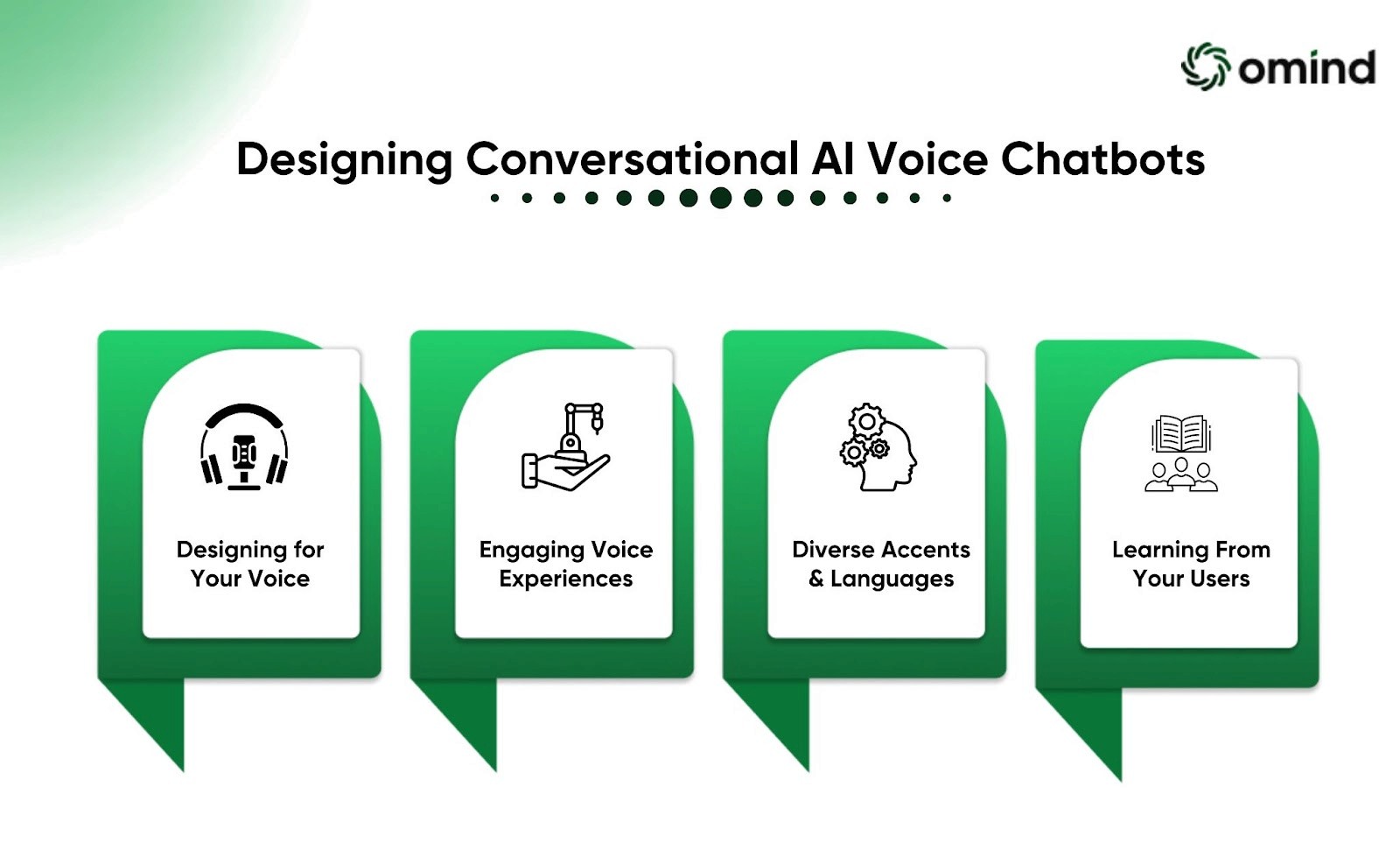AI voice chatbots are a booming technology in many fields. They understand and reply to your spoken words, making interactions more natural and engaging. How does it feel? Great! Unlike traditional text-based chatbots that require typing, voice technology lets you speak your queries or commands with more user experience.
The main difference between text and voice lies in their input and output methods. Text-based chatbots rely on written text for conversation, while voice chatbots use speech technologies such as Text-to-Speech (TTS) and Speech-to-Text (STT). Both types utilize Natural Language Processing (NLP) to understand the conversation's content. NLP understands your voice, STT converts your speech into text, and TTS allows the chatbot to reply with artificial speech.
It improves user experiences (UX) and makes interactions faster and more convenient. Instead of typing, you can use a voice chatbot for help. Implementing voice chatbots can boost user engagement. It is essential for a smooth and efficient way for users to interact. So, using an ally like a voice chatbot can improve your customer service and benefit your team.
Core Components of AI Voice Chatbots

The basic idea of how this voice chatbot works is clear now, but learning it in detail will help you understand the technology well. So, let's learn what makes it work.
Natural Language Understanding (NLU)
How do voice chatbots understand what you're saying? Have you ever thought of it? NLU works its magic by interpreting the user's purpose from their spoken words, allowing the chatbot to understand the situation and its meaning. This is the reason the chatbot can reply to your questions and commands. It can also handle various languages and dialects, making this technology available to a global audience. Omind's NLU capabilities are powerful in interpreting varied queries, making it a comprehensive solution for diverse users.
Speech Recognition
Speech recognition skills are a technology that converts your spoken words into text. This process understands your input very well. Without this, the chatbot couldn't understand your requests, making it viral to this interaction. More than that, the current speech recognition systems can adapt to different accents and speech patterns that help achieve more accuracy.
Text-to-Speech Conversion
Do you like human-like answers from a chatbot? Text-to-speech (TTS) translation makes this happen. It may create spoken responses from the chatbot, making the exchange more natural and engaging. This is unavoidable in user experience, especially in hands-free situations. Tailoring TTS is often possible with different sounds and tones that allow businesses to choose a voice that best represents their brand, depending on the specific TTS provider's capabilities. If you are looking for a TTS representing your brand voice, a provider like Omind can be helpful to your business.
Dialogue Management
Dialogue management helps chatbots keep the context of a conversation. This allows the chatbot to remember previous interactions and react logically and reasonably. This is a very relevant system for building easy and meaningful dialogues with users. The system handles multiple conversation threads, ensuring users can switch subjects without confusion.
Designing Conversational AI Voice Chatbots

Now that you understand how this technology works let's get down to business and learn how a firm can design a conversational AI voice chatbot.
Designing for Your Voice (VUIs): Consider a website designed for a little phone screen. It must be irritating for you, right? The same applies to voice robots. Voice User Interface (VUI) design best practices include employing natural language, crafting concise and clear requests, and providing open ways for clients to communicate with the chatbot via voice commands. Implementing these best practices is easier when you choose a platform like Omind, which provides comprehensive support in VUI design.
Engaging Voice Experiences: People are busy in this world, and their attention is scattered around different places. So, building interesting voice experiences is key to your business. What does it include? For instance, using a conversational tone, giving helpful advice throughout the interaction, and adding a touch of humor are part of it.
Diverse Accents & Languages: The world is diverse, and people experience different accents, dialects, and even multiple languages. When designing your voice chatbot, you must consider all these points. A company can use speech recognition tools or language selection options to tackle this situation.
Learning From Your Users: Conversation is essential for the voice chatbot to grow and improve. So, user feedback is a great resource that you can use. This involves surveys, A/B testing, or even allowing users to rate their satisfaction after each exchange. Listening to your users improves interactions and makes customers delightful to use.
Use Cases for AI Voice Chatbots
How we communicate with technology has changed since the arrival of voice chatbots. Let's take a look into some exciting use cases where voice robots are making a real difference:
Call Centers: Have you ever waited long to get your service? But you don't have to when this technology is available. Call centers use voice chatbots to automate routine questions, like checking account balances, scheduling meetings, or resetting passwords. This will save executives time for more complex issues. A firm can improve total customer service efficiency and satisfaction through this technology.
Hospitality: Hospitality creates a wonderful experience for customers. Chatbots are available 24/7 through smart speakers in hotel rooms. Now, guests can use their voices to order room service or get suggestions for local attractions without leaving their rooms. This tailored method increases guest comfort and convenience, making their stay truly outstanding.
Healthcare: The healthcare industry can use voice chatbots to improve patient engagement. With this innovation, getting appointments, refilling prescriptions, or even getting answers to basic medical questions is easy now. Healthcare can also offer basic mental health support or relaxation techniques with this technology. Looking to boost your healthcare services? Omind's chatbot technology could be the perfect fit.
eCommerce: Voice chatbots are useful for transforming how you shop online. You can ask the chatbot for product recommendations based on your preferences or even check out and finalize your purchase through voice commands. This is a good method to boost customer satisfaction and increase sales.
Banking and Finance: The world is becoming increasingly digital, especially in the financial sector. Omind's platform excels in these areas and could be the ideal choice for your needs. Now, a bank can check account balances, move funds, or get help with budgeting. Banks also use chatbots to answer frequently asked questions and collect customer feedback.
How AI Chatbots Benefit Businesses and Customers?
AI voice technology is rapidly changing how businesses and customers interact with them. These innovative tools have advantages for both companies and their customers.
By using voice chatbots, a business can reduce costs associated with traditional customer service operations. Automation jobs such as meeting scheduling or order processing can simplify workflows.
This is one of the amazing technologies that can give you immediate support with basic queries. Not only that, but 24/7 availability also means customers can get help whenever they need it, day or night.
Voice chatbots can streamline operational efficiency by automating repetitive tasks and giving consistent answers. This improves customer service and reduces the possibility of human error.
Voice chatbots' personalized and prompt help can improve customer engagement metrics such as satisfaction rates and loyalty. This can help a company build stronger relationships and a more positive brand image.
Building Your Own AI Voice Chatbot

Now that you're armed with the knowledge of voice chatbots, you might be considering creating your own. Here's a roadmap to guide you through the process:
Selecting the Right Platform: The first step is choosing the right voice bot platform. Look for NLU capabilities, scalability, language support, and, more than that, how it grows your business. A strong NLU will interpret diverse queries, while flexibility ensures it can handle growing user demands. You can also check if broad language support can help you reach a bigger audience.
Integration with Existing Systems: Integration with existing systems is one vital aspect you must consider before selecting one. The voice chatbot should easily connect with your CRM, databases, and other tools you are already using. This integration enhances user experience (UX) and streamlines your internal processes.
Data Privacy and Security: Privacy and security are the most important considerations when using customer data. The company you choose must adhere to laws like GDPR or CCPA, protect user data at all times, and use strong security methods to safeguard private information and build user trust.
Monitoring and Continuous Improvement: Monitoring and ongoing improvement based on user feedback are essential parts of using chatbots. Regularly analyze and gather feedback to identify areas for improvement. This is essential for your chatbot to be better and more efficient. Omind's platform excels in these areas and could be the ideal choice for your needs.
Market Outlook
AI voice chatbots are happening now, and the future looks bright. Let's delve into the current trends, consider what lies ahead, and explore the key players shaping this dynamic world.
The adoption of AI speech chatbots is increasing now. Industry reports project a CAGR (Compound Annual Growth Rate) exceeding 20%, with the market size expected to reach billions of dollars within the next few years. This surge is caused by several factors, including:
The widespread use of smart speakers and voice assistants like Alexa and Google Assistant ensures their relevance among users. People need simplicity and speed, and the voice chatbot offers an easy way to connect with technology. It also uses data to provide personalized experiences, tailoring answers and suggestions to individual needs and preferences.
The Evolving Landscape
The voice chatbot scene is a fascinating mix of established tech giants and innovative startups. Here's how each plays an important role:
Tech Giants: Large companies like Google, Amazon, and Microsoft are investing greatly in voice technology. They are building advanced NLU (Natural Language Understanding) algorithms and powerful voice assistant platforms, setting the groundwork for wider chatbot adoption. Companies like Omind are keeping pace with these industry leaders, offering cutting-edge technology for an optimized user experience.
Startups: Startups are at the forefront of this technology. They are experimenting with new uses for voice chatbots and creating specialized chatbot platforms for specific industries.
Final Word
AI voice chatbots are making reality possible and helping customers find things more easily than before. They offer companies and customers a natural, convenient, and personalized experience. As technology improves, so do the capabilities of voice chatbots. The future looks very bright with these technologies and changes in communication in every field. Many companies, such as Omind, lead the race in voice chatbots.
Imagine a provider who carefully directs a group of technologies to create a perfect voice chatbot experience. Omind's AI and data analysis craft chatbots that understand your purpose react naturally, and keep the conversation flowing. Visit Omind's website today and be a forerunner in providing exceptional customer experiences.
AUTHOR
Team Omind
Empowering Businesses with Unified Customer Experience Platform, Leveraging Advanced AI and Intelligent Automation
PRODUCT
Gen AI Voicebot
Share LINK
Related Blogs




